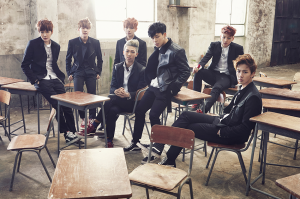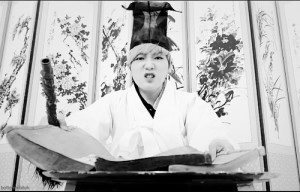A table full of Hite beer, the clinking of soju glasses and a visit to a noraebang — it is pretty apparent that Psy is set on introducing the world to a few Korean brands and conventions with his latest MV for “Hangover”.
But not only the visual aspect of his latest single focuses on Korean culture. In “Hangover”, the listener also stumbles upon another distinctly Korean feature that many might not be able to identify immediately. It is the sound of the Taepyeongso, a Korean wind instrument mostly used in the context of folk and occasionally religious music, which so violently attempts to yank the listener out of their own hangover/distractedness during the chorus.
[youtube http://youtu.be/HkMNOlYcpHg]
Interestingly, Psy is not the first one to feature traditional Korean elements in either his MV or his song this year. Topp Dogg already preceded him a few months ago with “Arario”, the music video of which is filled with references to Korean culture and the instrumental track of which uses many more traditional instruments than the janggu and gayageum the viewer can see in the MV.
Yet, Topp Dogg aren’t the first to have brought Gugak, the traditional music of Korea, into K-pop either. Considering that Seo Taiji & Boys already included Taepyeongso sounds in “Hayeoga”, a single off their second album from 1993, it wouldn’t be a stretch to say that the fusion of K-pop and Gugak is actually as old as the genre itself.
Still, it is noticeable that the last years have seen an increase in popular songs which dare to combine the two. The use of the haegeum in Infinite‘s “The Chaser” and the use of Samul nori in B.A.P‘s “No Mercy” are good examples of that. Other artists have also included traditional instruments on B-sides such as TVXQ‘s “Maximum” (which sees e.g. the use of the Gayageum) or recently EXO‘s “Love Love Love” (it is possible that the Gayageum and/or Haegeum were used in this song).
In addition to this, KBS aired a program named K-pop, to Find Its Way within Gugak earlier this year. In this program, artists like B1A4 and Bobby Kim collaborated with Gugak musicians and singers to create songs which combine aspects from both genres.
 But besides the instrumental side, this development of bringing traditional cultural elements into K-pop might have also had an influence on the lyric writing of certain groups. It is noteworthy that the two most well-known uses of satoori (Korean dialect) in K-pop took place in the songs of groups which focus heavily on rap: There is once again B.A.P’s “No Mercy”, as well as the adequately named “팔도강산 (Satoori Rap)” by BTS (the Naver dictionary translates “팔도강산” as “the scenery of all parts of Korea”).
But besides the instrumental side, this development of bringing traditional cultural elements into K-pop might have also had an influence on the lyric writing of certain groups. It is noteworthy that the two most well-known uses of satoori (Korean dialect) in K-pop took place in the songs of groups which focus heavily on rap: There is once again B.A.P’s “No Mercy”, as well as the adequately named “팔도강산 (Satoori Rap)” by BTS (the Naver dictionary translates “팔도강산” as “the scenery of all parts of Korea”).
Now, all of this is very interesting but readers might question themselves why exactly such a development has taken place. As is often the case, there is no clear-cut answer to this but one can try to speculate on the basis of the knowledge accumulated so far.
For one, K-pop has long had to deal with the accusation of being a potpourri of Western musical influences in which the Korean lyrics are the only genuinely Korean component. In this regard, the use of traditional instruments and other traditional Korean objects (like the Hanbok in Topp Dogg’s “Arario”) might be an attempt to distance oneself from such accusations and to make K-pop stand out among all the other pop genres in the world.
Furthermore, the use of these traditional elements could also be directed at the foreign listeners and viewers in so far as it could introduce them to aspects of the Korean culture, which might increase interest and tourism in South Korea — something that the K-entertainment industry can massively profit from as well.
But especially the use of satoori in songs could also be, and probably is, directed mainly at Korean listeners. It might be an appeal to Koreans to be proud of themselves and their origin, since much focus in the Korean media seems to lie on the modernity of Seoul and it’s dialect whilst other dialects are mainly a source of amusement.
 In a way, it makes perfect sense that the still very young K-pop genre and Gugak are merged more and more as time goes on. K-pop, and within that especially Psy, could be said to represent the growing international relevance of South Korea. It is only natural that the pride of this achievement causes people to look back on their history and for them to try and create a link between the two. It will be fascinating to follow this development further — who knows, maybe we’ll soon be able to witness the first K-pop song to feature a massive chunk of traditional, Pansori-style singing.
In a way, it makes perfect sense that the still very young K-pop genre and Gugak are merged more and more as time goes on. K-pop, and within that especially Psy, could be said to represent the growing international relevance of South Korea. It is only natural that the pride of this achievement causes people to look back on their history and for them to try and create a link between the two. It will be fascinating to follow this development further — who knows, maybe we’ll soon be able to witness the first K-pop song to feature a massive chunk of traditional, Pansori-style singing.
(officialpsy, STARDOM Entertainment, Seo Taiji Argentina, KBS World TV, woolliment, TSENT2008, danvy1410, KPOPMusicBox B, kimoi21200, YouTube[1][2][3][4][5][6][7][8][9]; maddieloveskpop[1][2], /r/kpopslumberparty, roboseyo, seoultonight, Wikipedia[1][2][3][4][5][6][7]; images via YG Entertainment, Big Hit Entertainment, Stardom Entertainment)


